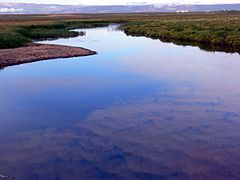
On an island like Iceland, the rivers are short in length. None of the rivers are important as a means of navigation due to the impracticality of settlements in the Highlands of Iceland where they originate.

On an island like Iceland, the rivers are short in length. None of the rivers are important as a means of navigation due to the impracticality of settlements in the Highlands of Iceland where they originate.
